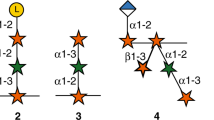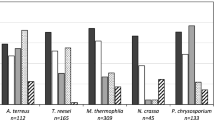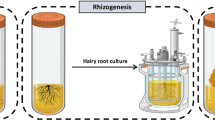Abstract
The development of alternatives to fossil fuels as an energy source is an urgent global priority. Cellulosic biomass has the potential to contribute to meeting the demand for liquid fuel, but land-use requirements and process inefficiencies represent hurdles for large-scale deployment of biomass-to-biofuel technologies. Genomic information gathered from across the biosphere, including potential energy crops and microorganisms able to break down biomass, will be vital for improving the prospects of significant cellulosic biofuel production.
This is a preview of subscription content, access via your institution
Access options
Subscribe to this journal
Receive 51 print issues and online access
$199.00 per year
only $3.90 per issue
Buy this article
- Purchase on Springer Link
- Instant access to full article PDF
Prices may be subject to local taxes which are calculated during checkout


Similar content being viewed by others
References
Hill, J., Nelson, E., Tilman, D., Polasky, S. & Tiffany, D. Environmental, economic, and energetic costs and benefits of biodiesel and ethanol biofuels. Proc. Natl Acad. Sci. USA 103, 11206–11210 (2006)
Tilman, D., Hill, J. & Lehman, C. Carbon-negative biofuels from low-input high-diversity grassland biomass. Science 314, 1598–1600 (2006)A demonstration of why grassland perennials, such as switchgrass, are superior for biofuel production when compared to crops that presently serve as food crops, such as soya bean or maize.
Himmel, M. E. et al. Biomass recalcitrance: engineering plants and enzymes for biofuels production. Science 315, 804–807 (2007)
Reddy, N. & Yang, Y. Biofibers from agricultural byproducts for industrial applications. Trends Biotechnol. 23, 22–27 (2005)
van Wyk, J. P. Biotechnology and the utilization of biowaste as a resource for bioproduct development. Trends Biotechnol. 19, 172–177 (2001)A discussion of biowaste as a potential source of lignocellulose for biofuel production.
Del Rio, J. C., Marques, G., Rencoret, J., Martinez, A. T. & Gutierrez, A. Occurrence of naturally acetylated lignin units. J. Agric. Food Chem. 55, 5461–5468 (2007)
Sanderson, K. US biofuels: a field in ferment. Nature 444, 673–676 (2006)
Doebley, J. F., Gaut, B. S. & Smith, B. D. The molecular genetics of crop domestication. Cell 127, 1309–1321 (2006)
Tuskan, G. A. et al. The genome of black cottonwood, Populus trichocarpa (Torr. & Gray). Science 313, 1596–1604 (2006)
Yu, J. et al. A draft sequence of the rice genome (Oryza sativa L. ssp. indica). Science 296, 79–92 (2002)
Goff, S. A. et al. A draft sequence of the rice genome (Oryza sativa L. ssp. japonica). Science 296, 92–100 (2002)
The Arabidopsis Genome Initiative Analysis of the genome sequence of the flowering plant Arabidopsis thaliana . Nature 408, 796–815 (2000)
Kalluri, U. C., Difazio, S. P., Brunner, A. M. & Tuskan, G. A. Genome-wide analysis of Aux/IAA and ARF gene families in Populus trichocarpa . BMC Plant Biol. 7, 59 (2007)
Busov, V. B., Brunner, A. M. & Strauss, S. H. Genes for control of plant stature and form. New Phytol. 177, 589–607 (2008)
Ragauskas, A. J. et al. The path forward for biofuels and biomaterials. Science 311, 484–489 (2006)
Filichkin, S. A. et al. Efficiency of gene silencing in Arabidopsis: direct inverted repeats vs. transitive RNAi vectors. Plant Biotechnol. J. 5, 615–626 (2007)
Dinus, R. J., Payne, P., Sewell, M. M., Chiang, V. L. & Tuskan, G. A. Genetic modification of short rotation poplar wood properties for energy and fiber production. Crit. Rev. Plant Sci. 20, 51–69 (2001)
LaForge, F. B. & Hudson, C. S. The preparation of several useful substances from corn cobs. J. Ind. Eng. Chem. 10, 925–927 (1918)
Mosier, N. et al. Features of promising technologies for pretreatment of lignocellulosic biomass. Bioresour. Technol. 96, 673–686 (2005)
Gilbert, H. J. Cellulosomes: microbial nanomachines that display plasticity in quaternary structure. Mol. Microbiol. 63, 1568–1576 (2007)
Viikari, L., Alapuranen, M., Puranen, T., Vehmaanpera, J. & Siika-Aho, M. Thermostable enzymes in lignocellulose hydrolysis. Adv. Biochem. Eng. Biotechnol. 108, 121–145 (2007)
Hugenholtz, P. Exploring prokaryotic diversity in the genomic era. Genome Biol. 3, REVIEWS0003 (2002)
Warnecke, F. et al. Metagenomic and functional analysis of hindgut microbiota of a wood-feeding higher termite. Nature 450, 560–565 (2007)A metagenomic study of an invertebrate gut microbial community involved in lignocellulolytic degradation.
van Maris, A. J. et al. Alcoholic fermentation of carbon sources in biomass hydrolysates by Saccharomyces cerevisiae: current status. Antonie Van Leeuwenhoek 90, 391–418 (2006)
Wang, M., Zhao, J., Yang, Z. & Du, Z. Electrochemical insights into the ethanol tolerance of Saccharomyces cerevisiae . Bioelectrochemistry 71, 107–112 (2007)
Georgieva, T. I., Mikkelsen, M. J. & Ahring, B. K. High ethanol tolerance of the thermophilic anaerobic ethanol producer Thermoanaerobacter BG1L1. Central Eur. J. Biol. 2, 364–377 (2007)
Jeffries, T. W. et al. Genome sequence of the lignocellulose-bioconverting and xylose-fermenting yeast Pichia stipitis . Nature Biotechnol. 25, 319–326 (2007)
Ohta, K., Beall, D. S., Mejia, J. P., Shanmugam, K. T. & Ingram, L. O. Genetic improvement of Escherichia coli for ethanol production: chromosomal integration of Zymomonas mobilis genes encoding pyruvate decarboxylase and alcohol dehydrogenase II. Appl. Environ. Microbiol. 57, 893–900 (1991)A description of the genetic modification of E. coli , yielding a strain capable of fermenting pentose and hexose sugars—which are present in lignocellulose—into ethanol.
Jarboe, L. R., Grabar, T. B., Yomano, L. P., Shanmugan, K. T. & Ingram, L. O. Development of ethanologenic bacteria. Adv. Biochem. Eng. Biotechnol. 108, 237–261 (2007)
Yomano, L. P., York, S. W. & Ingram, L. O. Isolation and characterization of ethanol-tolerant mutants of Escherichia coli KO11 for fuel ethanol production. J. Ind. Microbiol. Biotechnol. 20, 132–138 (1998)
Durre, P. Biobutanol: an attractive biofuel. Biotechnol. J. 2, 1525–1534 (2007)
Atsumi, S., Hanai, T. & Liao, J. C. Non-fermentative pathways for synthesis of branched-chain higher alcohols as biofuels. Nature 451, 86–89 (2008)
Lartigue, C. et al. Genome transplantation in bacteria: changing one species to another. Science 317, 632–638 (2007)
Merchant, S. S. et al. The Chlamydomonas genome reveals the evolution of key animal and plant functions. Science 318, 245–250 (2007)
Gioia, J. et al. Paradoxical DNA repair and peroxide resistance gene conservation in Bacillus pumilus SAFR-032. PLoS ONE 2, e928 (2007)
Taylor, L. E. et al. Complete cellulase system in the marine bacterium Saccharophagus degradans strain 2-40T. J. Bacteriol. 188, 3849–3861 (2006)
Lykidis, A. et al. Genome sequence and analysis of the soil cellulolytic actinomycete Thermobifida fusca YX. J. Bacteriol. 189, 2477–2486 (2007)
Nolling, J. et al. Genome sequence and comparative analysis of the solvent-producing bacterium Clostridium acetobutylicum. J. Bacteriol. 183, 4823–4838 (2001)
Bao, Q. et al. A complete sequence of the T. tengcongensis genome. Genome Res 12, 689–700 (2002)
Seo, J. S. et al. The genome sequence of the ethanologenic bacterium Zymomonas mobilis ZM4. Nature Biotechnol. 23, 63–68 (2005)
Acknowledgements
I would like to thank S. Tringe, M. Hess, J. Tuskan, P. Hugenholtz, J. Bristow, B. Simmons, S. Long, J. Fruchart-Najib and H. Blanch for their input to the manuscript. This work was performed under the auspices of the US Department of Energy’s Office of Science, Biological and Environmental Research Program, and by the University of California, Lawrence Berkeley National Laboratory under contract number DE-AC02-05CH11231, Lawrence Livermore National Laboratory under contract number DE-AC52-07NA27344, and Los Alamos National Laboratory under contract number DE-AC02-06NA25396.
Author information
Authors and Affiliations
Corresponding author
PowerPoint slides
Rights and permissions
About this article
Cite this article
Rubin, E. Genomics of cellulosic biofuels. Nature 454, 841–845 (2008). https://doi.org/10.1038/nature07190
Issue Date:
DOI: https://doi.org/10.1038/nature07190
This article is cited by
-
Arachis hypogaea’s concentration effect on AISI 1020 carbon steel for corrosion protection
Journal of Engineering and Applied Science (2024)
-
Combination of deep eutectic solvent and diluted acid pretreatments for sugarcane bagasse fractionation
Brazilian Journal of Chemical Engineering (2024)
-
Enhancement of solvent tolerance and economical bioethanol production by modulated sigma 54 expression of Pseudomonas putida
Biomass Conversion and Biorefinery (2024)
-
A review of the traditional pulping methods and the recent improvements in the pulping processes
Biomass Conversion and Biorefinery (2024)
-
Integrative omics analyses of the ligninolytic Rhodosporidium fluviale LM-2 disclose catabolic pathways for biobased chemical production
Biotechnology for Biofuels and Bioproducts (2023)
Comments
By submitting a comment you agree to abide by our Terms and Community Guidelines. If you find something abusive or that does not comply with our terms or guidelines please flag it as inappropriate.



